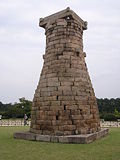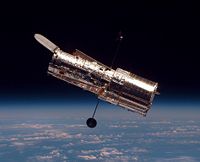Observatory
- This article is about scientific observatories. For the suburb of Cape Town, see Observatory, Cape Town.
An observatory is a location used for observing terrestrial and/or celestial events. Astronomy, climatology/meteorology, geology, oceanography and volcanology are examples of disciplines for which observatories have been constructed. Historically, observatories were as simple as containing an astronomical sextant (for measuring the distance between stars) or Stonehenge (which has some alignments on astronomical phenomena).
Astronomical observatories
Ground-based observatories
Ground-based observatories, located on the surface of Earth, are used to make observations in the radio and visible lights portions of the electromagnetic spectrum. Most optical telescopes are housed within a dome or other similar structure in order to protect the delicate instruments from the elements. Telescope domes contain a slat or other opening in the roof that can be opened during observing and then closed when the telescope is not in use. In most cases, the entire upper portion of the telescope dome can be rotated in order to allow the instrument to observe different sections of the night sky. Radio telescopes usually do not have domes.
Optical observatories
For optical telescopes, most ground-based observatories are located far from major centers of population in order to avoid the effects of light pollution. The ideal locations for modern observatories are sites that have dark skies, a large percentage of clear nights per year, dry air, and are at high elevations. At high elevations, the Earth's atmosphere is thinner thereby minimizing the effects of atmospheric turbulence and resulting in better astronomical "seeing".[1] Sites that meet the above criteria for modern observatories include the southwestern United States, Hawaii, the Andes Mountains, and Australia.[2] Major optical observatories include Mauna Kea, HI, USA, Roque de los Muchachos Observatory in the Canary Islands, Paranal Observatory in Chile and Kitt Peak observatory in the USA. The largest observatory in the equatorial belt is Observatorio Nacional de Llano del Hato in Venezuela.
Radio observatories
Beginning in the 1930's, radio telescopes have been built for use in the field of radio astronomy. Such an instrument, or a collection of them, with outbuildings for such things as control centres, data reduction centers, and maintenance are called radio observatories. Radio observatories are similarly located far from major centers of population in order to avoid electromagnetic interference (EMI) from radio, TV, radar, and other EMI emitting devices. But unlike optical observatories, radio observatories will be placed in valleys to further shield them from EMI. Some of the major radio observatories are at Socorro, in New Mexico, USA, Jodrell Bank in the UK, Arecibo, Puerto Rico and Parkes in New South Wales, Australia.
Space-based observatories
Space-based observatories are telescopes or other instruments that are located in outer space, many in orbit around the Earth. Space-based observatories can be used to observe astronomical objects at wavelengths of the electromagnetic spectrum that cannot penetrate the Earth's atmosphere and are thus impossible to observe using ground-based telescopes. The Earth's atmosphere is opaque to ultraviolet radiation, X-rays, and gamma rays and is partially opaque to infrared radiation so observations in these portions of the electromagnetic spectrum are best carried out from a location above the atmosphere of our planet.[3] Another advantage of space-based telescopes is that, because of their location above the Earth's atmosphere, their images are free from the effects of atmospheric turbulence that plague ground-based observations.[4] As a result, the angular resolution of space telescopes such as the Hubble Space Telescope is often much smaller than a ground-based telescope with a similar aperture. However, all these advantages do come with a price. Space telescopes are much more expensive to build than ground-based telescopes. Due to their location, space telescopes are also extremely difficult to maintain. The Hubble Space Telescope can be serviced by the Space Shuttle while many other space telescopes can not be serviced at all.[5]
Oldest astronomical observatories

Some of the oldest observatories include:
- Chankillo, Peru
- Abu Simbel, Egypt
- Stonehenge, Great Britain
- Kokino, Republic of Macedonia
- Goseck, Germany
- Ujjain, India
- Cheomseongdae, South Korea
- Angkor Wat, Cambodia
- Maragheh observatory, Iran
- El Caracol, Mexico
Volcano observatories
A Volcano observatory is an institution that conducts research and monitoring of a volcano. Mobile volcano observatories exist with the USGS VDAP (Volcano Disaster Assistance Program), to be deployed on demand.
See also
- Space observatory
- Timeline of telescopes, observatories, and observing technology
- List of astronomical observatories
- List of observatory codes
ReferencesISBN links support NWE through referral fees
- ↑ Chaisson, Eric and McMillan, Steve (2002). Astronomy Today, Fourth Edition. Prentice Hall, 116-119.
- ↑ Chaisson, Eric and McMillan, Steve (2002). Astronomy Today, Fourth Edition. Prentice Hall, 119.
- ↑ Chaisson, Eric and McMillan, Steve (2002). Astronomy Today, Fourth Edition. Prentice Hall.
- ↑ A Brief History of the Hubble Space Telescope: Why a Space Telescope?. NASA. Retrieved 2006-08-14.
- ↑ A Era of Space Telescopes. Space Telescope Science Institute. Retrieved 2006-09-14.
External links
- Dearborn Observatory Records, Northwestern University Archives, Evanston, Illinois
- Coordinates and satellite images of astronomical observatories on Earth
- Earth-based Observatories Profile by NASA's Solar System Exploration
- Ocean Observatory Information, Woods Hole Oceanographic Institution
- Climate Change Observing Systems Information from the Ocean & Climate Change Institute, Woods Hole Oceanographic Institution
- Milkyweb Astronomical Observatory Guide worlds largest database of astronomical observatories since 2001 - about 2000 entries
- Coastal Observatory Information from the Coastal Ocean Institute, Woods Hole Oceanographic Institution
- Map: Planetaria and Observatories
bg:Обсерватория cs:Hvězdárna da:Observatorium de:Sternwarte es:Observatorio eo:Observatorio fa:رصدخانه fr:Observatoire astronomique gl:Observatorio ko:천문대 hr:Opservatorij id:Observatorium it:Osservatorio astronomico he:מצפה כוכבים lb:Observatoire lt:Observatorija nl:Sterrenwacht ja:天文台 pl:Obserwatorium astronomiczne pt:Observatório ru:Обсерватория scn:Ossirvatoriu astronòmicu simple:Observatory sk:Observatórium sl:Observatorij sr:Опсерваторија fi:Observatorio sv:Observatorium th:หอดูดาว tr:Gözlemevi zh:天文台


